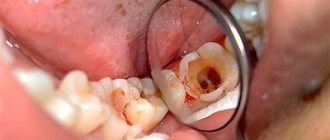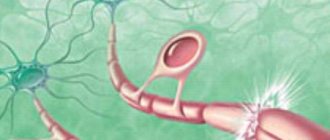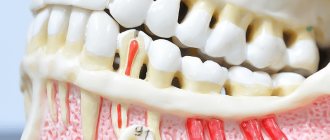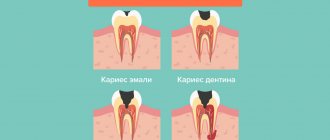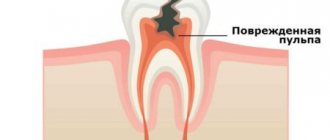From this article you will learn:
- methods of treating pulpitis in dentistry,
- how to remove a nerve from a tooth - video, stages of therapy,
- Is it painful to remove a nerve from a tooth?
Pulpitis is an inflammation of the neurovascular bundle located inside the tooth, which in dentistry is called the term “dental pulp.” The neurovascular bundle is located in the center of the tooth (in the cavity that dentists call the pulp chamber), as well as in the root canals. Through the tips of the root canals, the vessels and nerves of the pulp anastomose with the vessels and nerves outside the tooth. The name of such a disease as pulpitis arose from a combination of the word “pulp” and the ending “it” (the latter denotes the presence of inflammation).
In an article devoted to the reasons for the development of pulpitis (you can read them at the link above), we have already written that the main reason is long-term dental caries. As a result of the carious process in the hard tissues of the tooth, a carious cavity is formed, the walls of which contain a large amount of infection. When the thickness of healthy tooth tissue separating the pulp from the carious cavity becomes thin, the infection will begin to penetrate into the tooth cavity, causing inflammation of the pulp.
Inflammation of the pulp produces characteristic symptoms – pain. In most cases, treatment will require removal of the inflamed pulp from the tooth cavity and root canals, but in some cases conservative therapy is also possible. The latter is possible only in the early stages of inflammation and in certain groups of patients (we will also discuss this below).
What does the removed tooth pulp look like?
Symptoms of tooth pulpitis -
Pain with pulpitis can be of varying degrees of severity - from minor pain, which is provoked by thermal irritants, to acute paroxysmal spontaneous pain, which makes you want to climb the wall. Given the difference in symptoms, it is customary to distinguish 2 forms of this disease. Below we have described what pulpitis symptoms and treatment will have in each of these cases.
- Acute form of pulpitis – this form is characterized by acute paroxysmal pain that occurs especially at night.
It is typical that the pain increases, while pain-free intervals become shorter and shorter. As a rule, pain occurs spontaneously, i.e. without the participation, for example, of thermal stimuli. However, during the pain-free interval, in some cases it can be provoked by cold or hot water. With pulpitis, it is typical that after the removal of the irritant, the pain persists for about 10-15 minutes (this makes it possible to distinguish pain with pulpitis from pain with deep caries). With the latter, the pain stops immediately after the cessation of exposure to the stimulus. Very often, patients cannot even indicate which tooth exactly hurts, which is due to the irradiation of pain along the nerve trunks. The pain increases due to the gradual transition of inflammation from serous to purulent. With the development of purulent inflammation in the pulp, the pain becomes pulsating, shooting, and pain-free intervals almost completely disappear.
- Chronic form of pulpitis - in this form the inflammation is unexpressed. Patients usually complain of slight aching pain, most often arising from exposure to heat and cold irritants. Sometimes, by the way, with this form of pain there may be no pain at all. Keep in mind that the chronic form of pulpitis can periodically worsen, and during periods of exacerbation of inflammation, the symptoms will be exactly the same as in the acute form.
Causes of pulpitis
The main reason causing the development of pulpitis is caries, the treatment of which was not carried out on time. If a person delays treatment of caries until the last minute and does not go to the dentist, his risk of encountering pulpitis is extremely high, because caries is a constantly progressive disease that destroys tooth tissue. And sooner or later the destructive process reaches the pulp. Therefore, one of the basic principles of pulpitis prevention can be formulated as follows: if you don’t want to encounter pulpitis, don’t delay caries treatment!
Treatment of pulpitis will be much more complex and expensive than treatment of caries. Moreover, when treating advanced pulpitis, it is not always possible to save a tooth. Therefore, you need to forget about the fear of dentists and always consult a doctor in a timely manner for the treatment of caries! Nowadays, there are technologies that make it possible to successfully treat caries without pain and discomfort for the patient - for example, dental treatment under sedation, treatment without drilling a tooth.
Less commonly, pulpitis and the need for its treatment may arise for the following reasons:
1. Low quality of dental treatment. If, when treating caries, the dentist incorrectly treats the carious cavity or makes other mistakes and inaccuracies, tooth pulpitis may develop under the installed permanent filling.
2. Low quality of teeth preparation for prosthetics. Before prosthetics, the teeth are ground for the future prosthesis, and if, while working with a living tooth, the dentist overheats its tissues, pulpitis may develop. This will not happen immediately, but after some time, but pulpitis under the crown is almost always a sign of poor quality work by the orthopedic doctor. To treat pulpitis, the crown will have to be removed.
If you do not want to encounter pulpitis and other complications after poor-quality dental treatment, you must remember one simple rule: for dental treatment, you should not choose a clinic at the lowest price, but find out all the available information on its equipment and the level of qualifications of the doctors working there!
3. The cause of the development of pulpitis can also be gum disease. For example, periodontal disease causes exposure of tooth roots, and at the same time, a deep periodontal pocket is formed in the area of contact between the gum and tooth, in which pathogenic microorganisms will actively develop, causing the appearance of caries and then pulpitis. Therefore, treatment of gum inflammation also does not need to be postponed; if you see that your gums are inflamed, be sure to visit the dentist’s office!
Very rarely, pulpitis occurs due to injuries leading to tooth fracture. If the injury damaged not only the pulp, but also the root of the tooth, the only treatment that can be done is to remove the tooth.
For whatever reasons, pulpitis appears, its treatment must be carried out as urgently as possible. Timely and high-quality treatment of pulpitis makes it possible to keep the tooth alive, and, as you know, your natural teeth are better than any dentures!
Treatment of tooth pulpitis: methods
Treatment of pulpitis is most often carried out by depulping the tooth. This method involves completely removing the nerve in the tooth, after which the doctor mechanically expands and then fills the root canals. In young patients (provided they apply at an early stage of inflammation), it is possible to carry out treatment while preserving the living pulp of the tooth.
Of course, it is best to leave the nerve alive, because pulpless teeth become more fragile and also change their color to a grayer color. However, in most cases, the use of biological methods for treating pulpitis is impossible, because Patients extremely rarely apply at the very beginning of pulp inflammation (when the first symptoms have just appeared). Age also plays a decisive role in the choice of this method - this method is indicated for use only in people under 25-27 years of age.
Below we will talk in detail about the traditional treatment of pulpitis (read about the conservative method in the link above). By the way, according to official statistics, treatment of pulpitis is carried out poorly in 60-70% of cases, which requires subsequent retreatment of the tooth. This is due to poor-quality root canal filling.
Rinse
To relieve pain caused by inflammation of the pulp, rinsing with tinctures or decoctions of medicinal herbs is often used at home. This procedure has many advantages:
- relieves pain;
- reduces swelling and itching;
- eliminates pathogens;
- prevents the spread of the inflammatory process to healthy tissue.
For rinsing to be beneficial, it is necessary to repeat it after 2-3 hours and use water at a temperature comfortable for the oral cavity.
.
To prepare medicinal decoctions, dentists recommend using various plants: chamomile, dry sage, oak or willow bark, elderberry.
Sage
To prepare the decoction, you need to pour 5 tablespoons of dried sage with two glasses of hot water, bring to a boil over the fire and continue to simmer for 35-40 minutes. The liquid should sit for at least two hours, after which it should be strained, cooled and used to rinse the mouth every 2.5-3 hours.
A decoction of sage will help reduce fever, reduce pain and eliminate pathogenic microorganisms from the carious cavity.
willow bark
The peeled willow tree bark is thoroughly crushed using a grater or a sharp knife, after which two tablespoons of this substance are poured into a glass of boiling water and left for 40-50 minutes.
A well-strained product can be used to rinse the mouth to relieve pain, inflammation and swelling. Rinsing should be done less than three times a day, preferably after eating.
Bay leaf
The leaves of the bay tree must be thoroughly crushed, then pour a tablespoon of the resulting crumbs with a glass of boiling water and leave for about two hours.
The liquid filtered through gauze is used to rinse the painful area of the mouth three to five times a day. The resulting medicinal solution helps reduce swelling of the gums, reduce the number of bacteria and slow down the development of the inflammation process.
Knotweed and elderberry
To prepare a healing decoction, dried elderberry and knotweed flowers are crushed, then mixed in a small container, a full tablespoon of each herb, and poured with a liter of boiling water. The solution, steeped for one hour, is filtered and used to rinse teeth every 2-3 hours.
This medicinal composition has antiseptic, anti-inflammatory and analgesic effects.
Pomegranate peel
The peel of one or two pomegranate fruits must be cut, pour a liter of boiling water and simmer over low heat for 2 hours. After cooling, the liquid is filtered and used for rinsing every three hours.
This remedy helps prevent the progression of the disease and relieves the pain associated with it.
Propolis with calamus
The solution is prepared as follows:
- 3 tablespoons of dry propolis must be thoroughly crushed;
- the resulting mass should be poured with alcohol in an amount of 100 ml and left in a dark place for 3-4 days;
- Add calamus tincture to the strained alcohol infusion at a ratio of 1:2.
To rinse the mouth, you need to dilute a tablespoon of the prepared infusion with a glass of boiled or filtered water.
The effect of the product is to disinfect the cavity present in the molar and reduce inflammation of the gum tissue.
Soda
To prepare the solution, a teaspoon of soda is dissolved in a glass of boiling water. After the liquid reaches room temperature, rinse the oral cavity thoroughly, especially the area of inflammation. It is important to rinse at least three times a day, half an hour after meals.
A soda solution helps to disinfect the affected area of soft tissue, relieve inflammation and reduce pain.
Peroxide
Rinse the mouth with an aqueous solution of hydrogen peroxide three times a day. They will help eliminate infection from the carious cavity, reduce the number of pathogenic organisms in the mouth, thereby preventing the progression of the disease.
How to remove a nerve from a tooth - video, stages
Removal of the tooth nerve is a classic method of treating pulpitis. Its essence lies in the following steps:
- drilling out all tissues affected by caries (Fig. 2),
- removal of dental pulp (carried out using a special instrument),
- mechanical expansion of channels (Fig. 3),
- filling of tooth root canals (Fig. 4),
- filling the coronal part of the cube (Fig. 5).
Treatment of pulpitis: stages of tooth depulpation
Below we will describe in more detail each stage of treatment for pulpitis; perhaps this information will help you identify a would-be dentist and prevent poor-quality treatment and its complications.
Is it painful to treat pulpitis?
Pulpitis is actually an acute inflammation of the nervous tissue, so any manipulation of a diseased tooth can cause significant discomfort to the patient. However, the use of modern painkillers can reduce pain to a minimum. The least painful are conservative and devital surgical methods of treatment. Sometimes pain may persist for some time after treatment; in this case, the doctor may prescribe the patient to take painkillers. However, severe or prolonged pain after pulpitis treatment is often a sign of improper treatment and requires a second visit to the dentist.
Prevention of pulpitis is compliance with the rules of oral hygiene. Use toothpastes with sufficient mineral content, since thinned enamel is less resistant to initial caries and, as a result, inflammation of the pulp. Thus, Asepta Plus remineralization toothpaste will provide additional supply of minerals to the tooth, which is an excellent prevention of diseases of the teeth and gums.
Algorithm for the treatment of pulpitis using a specific example -
If you have pulpitis, treatment of a single-rooted tooth with one canal is usually carried out in 2 visits (at the second visit a permanent filling is already placed). In multi-rooted teeth, which have a significantly larger number of canals (from 2 to 4), pulpitis treatment is carried out in 3 visits.
The rule is categorical - a permanent filling on a tooth is not placed in the same visit as the root canal filling, i.e. The filling material in the root canals must first harden (moisture evaporates). Only after this can a permanent filling be placed. But to save time, some dentists neglect this. Below we will look at the algorithm for treating pulpitis of a multi-canal tooth in three visits.
Features and dangers of chronic pulpitis
Exacerbation of chronic pulpitis is characterized by severe pain.
Chronic pulpitis, in turn, is a more dangerous and serious form of the disease, which, by the way, may not bother a person so much.
The pain is most often aching and may disappear for several days or even weeks. Exacerbation of chronic pulpitis is characterized by severe pain that is difficult to tolerate, so a person immediately turns to a dentist for help and begins treatment.
The danger of chronic pulpitis lies in the fact that during the spread of infection, a person may experience virtually no discomfort. True, this does not stop the aching tooth from being a source of infection, which can continue to spread in any direction, and this is very serious.
First visit:
Anesthesia or is it painful to remove a nerve from a tooth?
How painful is it to treat pulpitis: It is definitely very painful if you decide to do it without anesthesia. Fortunately, modern anesthetics can completely solve this problem. If you still feel pain after anesthesia, this may be due to the anesthetic not being strong enough or the anesthesia technique being used incorrectly. The latter usually happens when the doctor tries to anesthetize large molars in the lower jaw (mandibular anesthesia, which is complex in technique, is performed there).
An example of anesthesia (video) –
Drilling out all carious tissues with a drill -
Firstly, at this stage all carious tissue is removed. Secondly, healthy tooth tissues are also partially removed, namely all tooth tissues above the pulp chamber and the mouths of the root canals. This is necessary to ensure visualization of the root canal orifices and ease of their processing with instruments. In Fig. 6-7 you can see the boundaries of excision of hard tooth tissues in the treatment of pulpitis. Figure 8 shows a view of the root canal mouths after they have drilled into the required amount of tooth tissue.
Tooth isolation from saliva –
This is done using a rubber dam. Isolation is necessary to prevent infection from the oral cavity from getting into the root canals along with saliva. This is standard international practice, but in Russia a rubber dam can often be seen only when a doctor fills a tooth. Normally, any work with root canals should be carried out using a rubber dam.
Removal of pulp from the tooth crown and root canals –
It is carried out with special tools designed to work in canals.
In Fig. 9 you can see tooth pulp wound around such a tool. By the way, video 1, which we posted above, shows the process of pulp removal. The video below clearly shows the moment when the tooth pulp is removed from the root canal (time – 1 minute 5 seconds). Treatment of pulpitis: video of nerve removal from a tooth
Measuring the length of root canals in a tooth –
This is one of the most important stages, because... if the length of each channel is determined incorrectly, it will cause -
- or underfilling of the canals, which will lead to complications after the end of treatment,
- or refilling the canals, which can lead to long-term pain and injury to the mandibular nerve.
Measuring the length of the canals is ideally carried out using a combination of the x-ray method and the use of an “apex locator”. In this case, first, special K-file instruments are introduced into each root canal in turn (Fig. 10), which are connected to the apex locator using a thin electrode (Fig. 12). The K-files are gradually advanced deeper into the root canal until there is a signal on the apex locator screen that the tip of the instrument has reached the apex of the tooth root.
It is necessary to measure each channel in turn, because The length of each channel is unique and there are no exact standards. After the measurements are completed and the data are recorded, K-files are simultaneously inserted into all channels (each to its own depth), and a control x-ray is taken (Fig. 11). The apex locator sometimes makes mistakes, so the x-ray will show how accurately the length of the canal was measured and whether adjustments are needed.
Mechanical processing of channels –
A budget option for mechanical treatment of root canals involves the use of manual files (K-files or reamers) - in Fig. 13 you can see a K-file in the root canal. The dentist rotates this instrument by the handle with his fingertips, and the cutting edges of the instrument excise chips from the walls of the canal, expanding it. The purpose of mechanical treatment is to widen the canal so that later it can be properly filled.
A better and more expensive processing option involves the use of an endodontic micromotor and special nickel-titanium files with shape memory. Mechanical processing of each channel is carried out to the depth determined at the previous stage. This is necessary to ensure that each root canal is filled exactly to the root apex. During the expansion process, it is very important to constantly rinse the canals with antiseptics, which is necessary for disinfection, but first of all, to wash out the shavings from the canal (24stoma.ru).
Mechanical treatment of root canals:
In video 1, you can see in detail how the expansion of root canals is carried out with ordinary hand instruments (for this, hand-held K-files of different diameters are used - from smaller to larger). In video 2, the dentist processes root canals using an endodontic micromotor and ProTaper Gold nickel-titanium profiles.
Placing a temporary filling –
After the canals are washed and dried to remove excess moisture, turundas soaked in antiseptic are left in them, and a temporary filling is applied to the tooth. The cost of treatment is calculated based on the number of root canals in the tooth.
Surgery
It is possible to understand what dental pulpitis is and how to treat the pathology in question, including through a detailed analysis of the techniques that require the use of any types of surgical interventions. The main indication for the use of such instructions is the presence in a person of a diffuse, focal and chronic inflammatory process of the fibrous and hypertrophic type. All activities are carried out according to strictly defined instructions:
- Anesthesia by introducing local, conduction anesthesia into the body.
- Isolate the affected area with sterile pads and pads.
- Opening the carious plane and treating the lesions with an antiseptic.
- Excision of the coronal part of the pulp extractor.
- Expanding the canals and treating them with antiseptic agents.
- Preliminary and final filling performed after x-rays.
It is not difficult to guess that only an experienced doctor with a variety of different skills can cope with a series of such procedures at the highest quality level. These are the specialists who work in dentistry.
Treatment of pulpitis with removal of the dental nerve
Another event characterized by a fairly high complexity. As a rule, all medical interventions are performed in two stages. During the first of them, the specialist:
- Removes the carious plane.
- Removes damaged tissue from the pulp itself.
- Treats the excision site with an antiseptic.
- Carrying out work on installing a temporary filling.
After approximately one to two weeks, the patient necessarily comes for the second session. As part of the additional (finishing) procedure, the following actions are carried out:
- Short-term filling is removed.
- Inspection and cleaning activities are carried out.
- The oral cavity is exposed to antiseptic agents.
- A permanent material is installed to fill the voids in the tooth process.
The main advantage of all processes is the possibility of preserving a healthy dental element. In addition, the person subsequently feels positive effects due to the regeneration of vitality and sensitivity of the pulp itself.
Treatment of pulpitis of a multi-rooted tooth
A devital technique, in which the doctor initially kills the problem area using a special necrotizing paste. In the past, doctors involved in such work used ordinary arsenic, placed in the carious plane for several days.
Today, modern medicine has stepped forward, providing craftsmen with a much wider range of tools. Dental staff use the most gentle drugs that do not kill nerve tissue in the oral cavity. It is not difficult to guess that the use of such substances is a completely safe operation.
Extirpation of pulpitis
Probably the most radical treatment method, which includes a whole complex of processes to remove the inflamed neurovascular bundle, followed by sanitation and filling. The doctor can undertake its implementation only in the case when any other methods of therapy clearly do not lead to success. As in previous cases, the procedure is carried out in a vital and non-vital format: under the influence of local anesthesia or using a necrotizing paste-like drug. Depending on how complex the disease is, the specialist may need from 3 to 4 sessions, the result of which, of course, will be a complete cure of the patient from the specified range of problems.
Second visit:
By the way, it is preferable to fill root canals without anesthesia, but this is not necessary. This is due to the fact that if a slight pain occurs when filling the canals, the doctor immediately understands that he has moved the gutta-percha pin beyond the apex of the root. Accordingly, the doctor can change the filling depth in time.
- Removing a temporary filling.
- Flushing the canals with antiseptics.
- Filling canals using gutta-percha and sealer - after the root canals have been washed and dried, it is necessary to seal them tightly.
This is done using gutta-percha pins of different sizes (Fig. 16) and a sealer (this is something like a paste). The pins are inserted into the root canals and compacted there. In Fig. 14-15 you can see the mouths of the root canals Before and After the canals were filled with gutta-percha. Read more about this stage in our article: → “Mechanical treatment and filling of canals for pulpitis”
- X-ray control of the filling ( required!!! ) if everything is OK on the x-ray, we proceed to the next stage.
But, if we see that the canal is not filled up to the apex, or the gutta-percha pins extend beyond the root into the surrounding tissues, it is necessary to remove all the gutta-percha pins and start filling the canals all over again. In Fig. 17-19 you can see well-sealed root canals (all root canals are sealed to the apex of the root). Unfortunately, it is worth noting that the vast majority of dentists, even if they see that the root canals are filled, do not redo the work. This is precisely what is connected with the percentage of poor-quality treatment of pulpitis that we announced at the beginning of the article (in 60-70% of cases). Type of high-quality filled root canals –
At the end of the visit, a temporary filling is placed, and the patient is warned that the tooth may begin to hurt after undergoing anesthesia. Good tablet analgesics will help relieve pain. A little pain is normal because... during instrumental work in canals, K-files slightly injure the tissue in the area of the root apex.
Diagnosis of the disease
During the appointment, the doctor interviews the patient. Determines the nature of pain, the conditions for the manifestation of pain, intensity and duration. Then, he conducts an external inspection and tapping using hand tools. This allows us to identify the presence of a carious cavity, the density or, conversely, softness of the pulp, and assess the condition of the gums. After this, an x-ray is prescribed. It shows the condition of internal tissues and channels, the localization and extent of inflammation.
In some cases, electroodontodiagnosis is prescribed—this is an analysis of the tooth’s reaction to electricity. The study provides insight into the integrity and functionality of the nervous system. Normally, the pulp responds with a slight pain signal to the electricity passing through it. As caries progresses, degenerative processes occur that reduce the sensitivity of nerve receptors.

